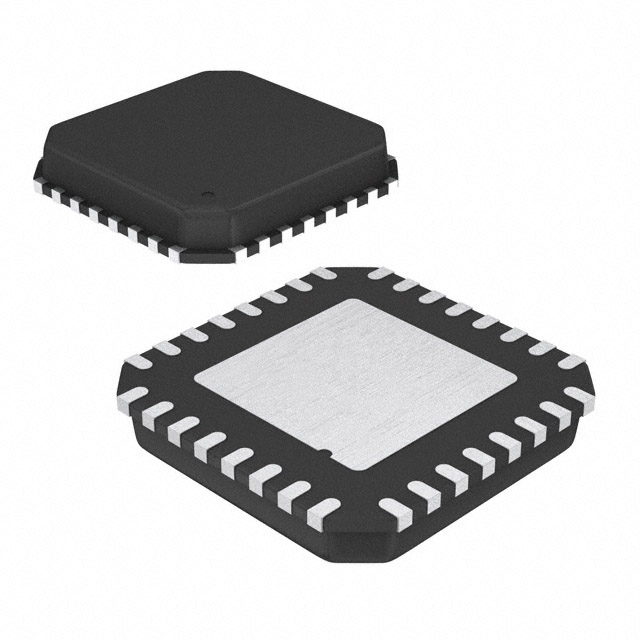ATMEGA48PA-MN
Product Overview
The ATMEGA48PA-MN belongs to the category of microcontrollers and is widely used in various electronic applications. Known for its high performance and versatility, this microcontroller offers a wide range of characteristics and features that make it suitable for diverse applications. The package type, essence, and packaging/quantity details are essential aspects to consider when utilizing the ATMEGA48PA-MN.
Basic Information
- Category: Microcontroller
- Use: Embedded systems, industrial control, consumer electronics
- Characteristics: High performance, low power consumption, versatile I/O capabilities
- Package: 28-pin PDIP, 32-pin TQFP
- Essence: Versatile microcontroller with integrated peripherals
- Packaging/Quantity: Available in tubes or reels, quantity varies based on packaging
Specifications
The ATMEGA48PA-MN microcontroller offers the following specifications: - Flash Memory: 4 KB - SRAM: 512 bytes - EEPROM: 256 bytes - Operating Voltage: 1.8 - 5.5V - I/O Pins: 23 - ADC Channels: 6 - Timers: 2 (8-bit), 1 (16-bit) - Communication Interfaces: USART, SPI, I2C
Detailed Pin Configuration
The detailed pin configuration of the ATMEGA48PA-MN microcontroller is as follows:
| Pin Number | Function | |------------|----------------| | 1 | RESET | | 2 | VCC | | 3 | GND | | 4-11 | Port B (PB0-PB7)| | 12 | AVCC | | 13 | AREF | | 14-19 | Port C (PC0-PC5)| | 20 | GND | | 21-28 | Port D (PD0-PD7)|
Functional Features
The ATMEGA48PA-MN microcontroller offers the following functional features: - High-Performance CPU: Utilizes an advanced RISC architecture for efficient processing - Peripheral Integration: Integrated analog and digital peripherals for versatile applications - Low Power Consumption: Optimized power management for energy-efficient operation - Flexible I/O Capabilities: Supports a wide range of input/output configurations - Enhanced Communication Interfaces: Multiple communication interfaces for seamless connectivity
Advantages and Disadvantages
Advantages
- Versatile and adaptable for various applications
- Low power consumption for energy-efficient designs
- Integrated peripherals reduce external component count
Disadvantages
- Limited memory and I/O capabilities compared to higher-end microcontrollers
- Restricted processing power for complex computations
Working Principles
The ATMEGA48PA-MN operates based on the principles of embedded system design, utilizing its integrated CPU, memory, and peripherals to execute programmed tasks. It follows a sequential execution model, interacting with external devices through its I/O pins and communication interfaces.
Detailed Application Field Plans
The ATMEGA48PA-MN finds extensive application in the following fields: - Embedded Systems: Used in various embedded control systems for automation and monitoring - Industrial Control: Employed in industrial automation and process control applications - Consumer Electronics: Integrated into consumer products for user interface and control functionalities
Detailed and Complete Alternative Models
Some alternative models to the ATMEGA48PA-MN include: - ATMEGA88PA - ATMEGA168PA - ATMEGA328P
These alternative models offer varying memory, I/O, and peripheral configurations to cater to different application requirements.
In conclusion, the ATMEGA48PA-MN microcontroller stands as a versatile and reliable solution for embedded system designs, offering a balance of performance, power efficiency, and integrated features. Its widespread use across diverse industries underscores its significance in modern electronic applications.
Word Count: 536
Senaraikan 10 soalan dan jawapan biasa yang berkaitan dengan aplikasi ATMEGA48PA-MN dalam penyelesaian teknikal
What is the ATMEGA48PA-MN microcontroller used for?
- The ATMEGA48PA-MN microcontroller is commonly used in embedded systems for various applications such as industrial control, consumer electronics, and automation.
What are the key features of the ATMEGA48PA-MN?
- The ATMEGA48PA-MN features 4KB of Flash memory, 256 bytes of EEPROM, 512 bytes of SRAM, 23 general-purpose I/O lines, and a wide operating voltage range.
How do I program the ATMEGA48PA-MN?
- The ATMEGA48PA-MN can be programmed using various development tools such as Atmel Studio, AVR-GCC, or Arduino IDE with an appropriate programmer or bootloader.
What communication interfaces does the ATMEGA48PA-MN support?
- The ATMEGA48PA-MN supports serial communication through USART, SPI, and I2C interfaces, making it suitable for interfacing with other devices and peripherals.
Can the ATMEGA48PA-MN be used in low-power applications?
- Yes, the ATMEGA48PA-MN features multiple sleep modes and low-power consumption, making it suitable for battery-powered and energy-efficient applications.
What kind of peripherals can be interfaced with the ATMEGA48PA-MN?
- The ATMEGA48PA-MN can interface with various peripherals such as sensors, displays, motors, and communication modules through its GPIO, ADC, PWM, and communication interfaces.
Is the ATMEGA48PA-MN suitable for real-time applications?
- Yes, the ATMEGA48PA-MN offers precise timing capabilities, making it suitable for real-time applications such as control systems and data acquisition.
What development boards or evaluation kits are available for the ATMEGA48PA-MN?
- There are various development boards and evaluation kits available from Atmel and third-party manufacturers that support the ATMEGA48PA-MN, providing a convenient platform for prototyping and development.
Can the ATMEGA48PA-MN be used in automotive applications?
- The ATMEGA48PA-MN meets automotive temperature and quality standards, making it suitable for use in automotive applications such as engine control, dashboard displays, and infotainment systems.
Are there any known limitations or common issues when using the ATMEGA48PA-MN?
- While the ATMEGA48PA-MN is a versatile microcontroller, users should be aware of its limited memory and I/O capabilities compared to higher-end microcontrollers, and may need to carefully manage resources in complex applications.


